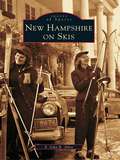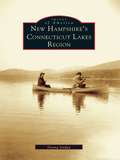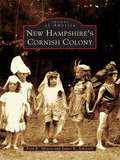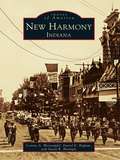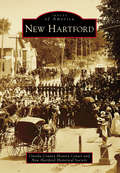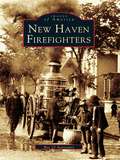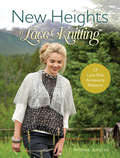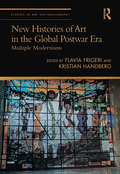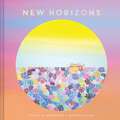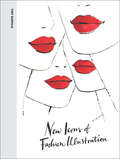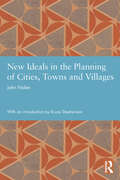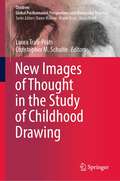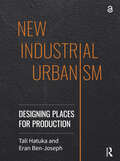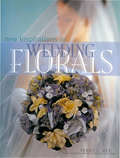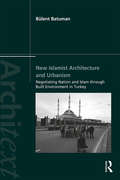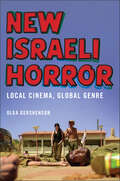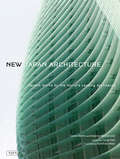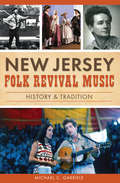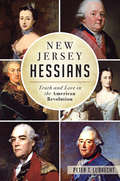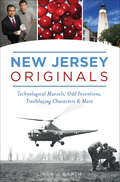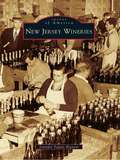- Table View
- List View
New Hampshire on Skis (Images of Sports)
by E. John AllenThe state of New Hampshire has a strong skiing tradition to brag about, and in the 1930s, it led the United States in ski activity. The early prominence of Dartmouth College's Outing Club and winter carnival was a major forerunner in the development of the sport and readied the state to receive the alpine impetus coming from Europe in the 1930s. Germans and particularly Austrians-some fleeing Nazi persecution-brought with them the expert downhill schuss and found the White Mountains suitable terrain. Rail excursions from Boston, well-plowed roads, help from the Civilian Conservation Corps, and entrepreneurial activity helped skiing take off, and many ski centers boasting rope tows opened.New Hampshire on Skis follows this development and the rise in popularity of skiing in the state. Such innovations as the Cannon Tram, operating from 1938, marked a high point of state-supported ski promotion. After World War II ended, development of ski areas began in earnest. In the late twentieth century and today, ski areas have combined their ski sport activity with other snow sports-snowboarding in particular. New Hampshire on Skis documents the growth of the ski industry in New Hampshire from its European beginnings to what is now one of the most popular winter destinations on the East Coast.
New Hampshire's Connecticut Lakes Region
by Donna JordanThe Connecticut Lakes region is the last great frontier of the North Country. Forming the extreme northern tip of the state, it offers the only port of entry from Canada into New Hampshire. It includes Pittsburg, the most sizable township in the country-three hundred thousand acres in all-and the beautiful and wild Connecticut Lakes. Its fascinating history glistens in the two-hundred-plus images of New Hampshire's Connecticut Lakes Region. Pictured are rich logging lands, a mecca for sportsmen for more than a hundred years, and waterfront camps, cabins, and lodges. From 1832 to 1836, Pittsburg was known as the Indian Stream Republic, maintaining independence from both the United States and Canada.
New Hampshire's Cornish Colony
by Fern K. Meyers James B. AtkinsonNew Hampshire's Cornish Colony illustrates this distinguished American art colony. First settled in 1885 by colleagues of America's Michelangelo, Augustus Saint-Gaudens, the Cornish Colony was a retreat for sculptors, painters, writers, and musicians. They were attracted to this peaceful valley nestled in the New Hampshire hills in the shadow of Vermont's Mount Ascutney. Known as "the Athens of America," the Cornish Colony was a lively, glamorous society during its heyday from 1885 to 1925. One outstanding member, the famous artist Maxfield Parrish, was called a "chickadee" because he spent the entire year in Cornish, not merely the summer. In New Hampshire's Cornish Colony, discover a portrait of the colonists' society and the fascinating people who contributed to America's cultural legacy.
New Harmony, Indiana
by Darrel E. Bigham Susan R. Branigin Connie A. WeinzapfelNew Harmony is a town like no other. A community thatbegan almost two hundred years ahead of its time, New Harmony was a spiritual sanctuary that later became a haven for international scientists, scholars, and educators who sought equality in communal living. It was impossible for George Rappto realize the events he would set into motion when he purchased 20,000 acres of land on the Wabash River in 1814 and subsequently sold it to social reformer Robert Owen ten years later. This simplecommunity came to have an immense impact on our country's art and architecture, public education system, women's suffrage movement, Midwestern industrial development, and more. This book contains over 150 historic images produced by two 19th-century New Harmony photographers--Homer Fauntleroyand William Frederick Lichtenberger. These photographs show historic buildings of New Harmony, many of which have been razed over the years. They also demonstrate the importance of the Wabash River and its influence on settlement and commerce. The people of the community are captured at work and at play, and the reader is allowed a look at the downtown business district of the past and the farms surrounding it.
New Hartford (Images of America)
by New Hartford Historical Society Oneida County CenterAfter having gone bankrupt from a fire on his New Hampshire farm, Jedediah Sanger purchased 1,000 acres of land in Whitestown in 1788. This land, part of the Coxe Patent, came to be known as New Hartford. This new town was created when the town of Whitestown was divided in April 1827. The village of New Hartford was formed in 1870. Chadwicks, Middle Settlement, Washington Mills, and Willowvale also existed within the town. Throughout the early 19th century, industry flourished in New Hartford. The Sauquoit Creek supplied power to businesses, including tanneries, knitting mills, sawmills, and canning factories. Local farms provided adequate supplies of vegetables and meat. The installation of Seneca Turnpike boosted New Hartford’s economy as it became the main thoroughfare west from Utica. Prosperity followed, especially after Commercial Drive was developed in the 20th century. Today, New Hartford is Oneida County’s retail center.
New Haven Firefighters (Images of America)
by Box 22 AssociatesThe history of the New Haven Fire Department dates back to December 29, 1789, when Mayor Roger Sherman, a signer of the Declaration of Independence, formed the volunteer system. The advent of steam fire engines in 1862 marked the end of the volunteer system and the beginning of the full-time paid department, giving New Haven the distinction of having the first professional fire department in Connecticut. New Haven has a long and proud history of tradition in its fire service. Since 1862 there have been only fifteen different chiefs heading the department. New Haven Firefighters tells the story from the days of steamers to the era of the tower ladder.
New Haven's Sentinels: The Art and Science of East Rock and West Rock (The Driftless Connecticut Series)
by Jelle Zeilinga de Boer John WarehamWest Rock and East Rock are bold and beautiful features around New Haven, Connecticut. They resemble monumental gateways (or time-tried sentinels) and represent a moment in geologic time when the North American and African continents began to separate and volcanism affected much of Connecticut. The rocks attracted the attention of poets, painters, and naturalists when beliefs rose about the spiritual dimensions of nature in the early 19th century. More than two dozen artists, including Frederick Church, George Durrie, and John Weir, captured their magic and produced an assortment of classic American landscapes. In the same period, the science of geology evolved rapidly, triggered by the controversy between proponents and opponents of biblical explanations for the origin of rocks. Lavishly illustrated, featuring over sixty paintings and prints, this book is a perfect introduction to understanding the relationship of geology and art. It will delight those who appreciate landscape painting, and anyone who has seen the grandeur of East and West Rock.
New Heights In Lace Knitting: 17 Lace Knit Accessory Patterns
by Andrea JurgrauSet against the backdrop of the world's tallest peaks, author Andrea Jurgrau's New Heights in Lace Knitting helps knitters create a beautiful collection of lace shawls and accessories and gain confidence in creating standout knitted lace.Before starting any journey, knitters need to load their packs (or in this case, their knitting bags) with the right supplies. New Heights in Lace Knitting outlines exactly what knitters need in order to cerate a successful finished project. Knitters are guided through choosing the right yarns for lace, basic lace techniques, and a comprehensive how-to for adding beads to lace projects.Beginners might start with a smaller project, such as fingerless mitts with lace detail, while experienced knitters may start with a lace shawl project that challenges their know-how. In all, there are 17 lace patterns that knitters are going to love exploring.
New Histories of Art in the Global Postwar Era: Multiple Modernisms (ISSN)
by Flavia FrigeriThis book maps key moments in the history of postwar art from a global perspective. The reader is introduced to a new globally oriented approach to art, artists, museums and movements of the postwar era (1945–70). Specifically, this book bridges the gap between historical artistic centers, such as Paris and New York, and peripheral loci. Through case studies, previously unknown networks, circulations, divides and controversies are brought to light. From the development of Ethiopian modernism, to the showcase of Brazilian modernity, this book provides readers with a new set of coordinates and a reassessment of well-trodden art historical narratives around modernism. This book will be of interest to scholars in art historiography, art history, exhibition and curatorial studies, modern art and globalization.
New Histories of Art in the Global Postwar Era: Multiple Modernisms (Studies in Art Historiography)
by Flavia FrigeriThis book maps key moments in the history of postwar art from a global perspective. The reader is introduced to a new globally oriented approach to art, artists, museums and movements of the postwar era (1945–70). Specifically, this book bridges the gap between historical artistic centers, such as Paris and New York, and peripheral loci. Through case studies, previously unknown networks, circulations, divides and controversies are brought to light. From the development of Ethiopian modernism, to the showcase of Brazilian modernity, this book provides readers with a new set of coordinates and a reassessment of well-trodden art historical narratives around modernism. This book will be of interest to scholars in art historiography, art history, exhibition and curatorial studies, modern art and globalization.
New Horizons: The Art of Wandering
by Shirin SahbaThis vibrant and entrancing book invites readers on a journey around the world. Artist and globetrotter Shirin Sahba celebrates the diversity of people, places, and traditions, and revels in the joy of the journey itself. In exquisitely detailed paintings, she captures fleeting moments and small treasures—a brightly colored sari fluttering in the breeze, a mother and child enjoying gelatos on a hot Italian day, the mesmerizing pattern of an antique Chinese carpet. Along the way, the artist shares reflections, inspirations, and stories, immersing readers in each new landscape. Packaged in a petite square and featuring a shimmering foil-stamped cover, this book makes a special gift for nomads, graduates, retirees, or anyone setting off in search of their own new horizons.
New Icons of Fashion Illustration
by Tony GlenvilleFashion illustration is and always has been about far more than pretty drawings of pretty dresses. This lavish celebration of today’s leading artists in the field showcases the timeless craft and amazing diversity that characterize the genre. From David Downton to Cecilia Carlstedt and from Jason Brooks to Jordi Labanda, 28 masters of fashion illustration from across the world are featured, one by one, in a grand tour of the best work currently produced. While some illustrators create daringly bold graphics, others prefer delicate watercolours and ink drawings. Throughout the volume, both hi-tech multimedia effects and traditional drawing skills are given pride of place, with many of the artists using a mixture of techniques. Lively commentary accompanies the images, while interviews with each illustrator provide further insight into their influences and methods. A source of inspiration for aspiring illustrators, designers and advertising creatives, this gorgeous volume will also catch the eye of fashion lovers and all those who have an interest in contemporary figurative art and visual communication.
New Icons of Fashion Illustration
by Tony GlenvilleFashion illustration is and always has been about far more than pretty drawings of pretty dresses. This lavish celebration of today’s leading artists in the field showcases the timeless craft and amazing diversity that characterize the genre. From David Downton to Cecilia Carlstedt and from Jason Brooks to Jordi Labanda, 28 masters of fashion illustration from across the world are featured, one by one, in a grand tour of the best work currently produced. While some illustrators create daringly bold graphics, others prefer delicate watercolours and ink drawings. Throughout the volume, both hi-tech multimedia effects and traditional drawing skills are given pride of place, with many of the artists using a mixture of techniques. Lively commentary accompanies the images, while interviews with each illustrator provide further insight into their influences and methods. A source of inspiration for aspiring illustrators, designers and advertising creatives, this gorgeous volume will also catch the eye of fashion lovers and all those who have an interest in contemporary figurative art and visual communication.
New Ideals in the Planning of Cities, Towns and Villages: Town And City Planner (classic Reprint) (Studies in International Planning History)
by John NolenJohn Nolen’s New Ideals in the Planning of Cities, Towns, and Villages is the most thorough assessment of city planning written by an American practitioner before 1920. It records the interplay of urban reform in Europe and the United States, the rise of the planning expert, the design of new towns, and the technique for directing urban expansion on systematic lines. Most important, it documents the blueprint for investing the "peace dividend" of the Great War to make urban life "more fit for democracy". Written for men fighting to make the world safe for democracy, New Ideals revealed how the domestic part of the peace program could justify their sacrifice. The wartime housing initiative had improved the living conditions of industrial workers and the same public regulation and control of the layout and character of residential neighbourhoods could provide what "men of service expect to find on their return, a new and better type of workman’s home." While New Ideals strained towards the utopian, experience tempered Nolen’s expectations and the high aims of the book were not immediately realised in a post-war society seeking a return to pre-war normalcy. However in the last decade, Nolen’s planned communities have been closely studied as the demand for pedestrian-oriented neighbourhoods set on sustainable lines has moved from novelty to policy. New Ideals is an important text not only for its design template, but also its aspirations. Nolen’s call to "make cites that will serve the needs--physical, economic, and spiritual-- of all people" lays at the heart of the city planning profession and the lessons Nolen imparted inform a new generation planning cities to be both resilient and just.
New Images of Thought in the Study of Childhood Drawing (Children: Global Posthumanist Perspectives and Materialist Theories)
by Christopher M. Schulte Laura Trafí-PratsThis book provides a revitalised account of the study of children’s drawing by outlining a departure from existing approaches privileging developmentalist accounts and presenting drawing as a specialised human endeavour separated from other material entanglements constituting children’s everyday experiences. The book takes on current developments in the fields of early childhood arts and early childhood literacies to advocate for process-oriented, new materialist and decolonial approaches that re-conceptualise the study of children’s drawing. It proposes a future-oriented approach, centred on thinking experimentally with a focus on nonrepresentational elements, such as movement, sensation, intensity, rhythm, story and place, which singularly assemble in drawing events. Thus, the book discusses drawing as a process of sense-making that is not enclosed in the individualised body of the child and that unfolds corporeally in time and space. It revises the relation of drawing with symbolisation by suggesting that the use of language and signs in drawing form in entanglement with matter and sensation in processes of creative speculation connected with the movement of thought. Presenting a series of contributions by internationally recognised scholars and artists, the book aims to create synergies between theory and practice that speak of everyday realities interconnecting children, learning and sense-making.
New Independence! Environmental Adaptations in Community Facilities for Adults with Vision Impairments
by Maureen A. DuffyContents include: environmental changes and vision; evaluating the environment; modifying the environment; specific suggestions by area; useful resources, and a checklist for conducting environment evaluations. A book that can make a big difference!
New Industrial Urbanism: Designing Places for Production
by Tali Hatuka Eran Ben-JosephSince the Industrial Revolution, cities and industry have grown together; towns and metropolitan regions have evolved around factories and expanding industries. New Industrial Urbanism explores the evolving and future relationships between cities and places of production, focusing on the spatial implications and physical design of integrating contemporary manufacturing into the city. The book examines recent developments that have led to dramatic shifts in the manufacturing sector – from large-scale mass production methods to small-scale distributed systems; from polluting and consumptive production methods to a cleaner and more sustainable process; from broad demand for unskilled labor to a growing need for a more educated and specialized workforce – to show how cities see new investment and increased employment opportunities. Looking ahead to the quest to make cities more competitive and resilient, New Industrial Urbanism provides lessons from cases around the world and suggests adopting New Industrial Urbanism as an action framework that reconnects what has been separated: people, places, and production. Moving the conversation beyond the reflexively-negative characterizations of industry, more than two centuries after the start of the Industrial Revolution, this book calls to re-consider the ways in which industry creates places, sustains jobs, and supports environmental sustainability in our cities. This book is available as Open Acess through https://www.taylorfrancis.com/.
New Inspirations in Wedding Florals
by Terry RyeMake your wedding extraordinary with these inspired floral creations!For years to come, the colors and fragrances of your wedding flowers will be potent reminders of the big event. Now you can make those memories last forever with New Inspirations in Wedding Florals - a completely illustrated guide to making unique, innovative and exciting floral designs.Terry Rye provides step-by-step guidelines and expert advice for creating beautiful floral arrangements that reflect your taste and personality, look professional and are sure to make the big day unforgettable. It's like having your very own wedding floral consultant!You'll find 28 unique, beautiful projects with variations and clear instructions that will help make your wedding more special than you ever imagined.Projects include something for every aspect of your wedding:Bridal and bridesmaids' bouquetsCorsages, boutonnieres and flower girl accessoriesArrangements for the ceremony including pew decorationsTable centerpieces and wedding cake tops for the reception and more!Also included are planning tips, budgeting ideas and the best ways to choose a theme to create elegance and add a creative, personal touch.Bouquet projects include:Pearl and Ribbon BouquetGardenia Tassel BouquetIvy Collar Clutch BouquetVictorian Holiday BouquetCascade Nouveau BouquetExotic Calla Lily BouquetRosy Biedermeier BouquetAutumn Daisy BouquetTrailing Orchid BouquetGarden-Inspired Bouquet
New Islamist Architecture and Urbanism: Negotiating Nation and Islam through Built Environment in Turkey (Architext)
by Bülent BatumanNew Islamist Architecture and Urbanism claims that, in today’s world, a research agenda concerning the relation between Islam and space has to consider the role of Islamism rather than Islam in shaping – and in return being shaped by – the built environment. The book tackles this task through an analysis of the ongoing transformation of Turkey under the rule of the pro-Islamic Justice and Development Party. In this regard, it is a topical book: a rare description of a political regime's reshaping of urban and architectural forms whilst the process is alive. Defining Turkey’s transformation in the past two decades as a process of "new Islamist" nation-(re)building, the book investigates the role of the built environment in the making of an Islamist milieu. Drawing on political economy and cultural studies, it explores the prevailing primacy of nation and nationalism for new Islamism and the spatial negotiations between nation and Islam. It discusses the role of architecture in the deployment of history in the rewriting of nationhood and that of space in the expansion of Islamist social networks and cultural practices. Looking at examples of housing compounds, mosques, public spaces, and the new presidential residence, New Islamist Architecture and Urbanism scrutinizes the spatial making of new Islamism in Turkey through comparisons with relevant cases across the globe: urban renewal projects in Beirut and Amman, nativization of Soviet modernism in Baku and Astana, the presidential palaces of Ashgabat and Putrajaya, and the neo-Ottoman mosques built in diverse locations such as Tokyo and Washington DC.
New Israeli Horror: Local Cinema, Global Genre
by Olga GershensonBefore 2010, there were no Israeli horror films. Then distinctly Israeli serial killers, zombies, vampires, and ghosts invaded local screens. The next decade saw a blossoming of the genre by young Israeli filmmakers. New Israeli Horror is the first book to tell their story. Through in-depth analysis, engaging storytelling, and interviews with the filmmakers, Olga Gershenson explores their films from inception to reception. She shows how these films challenge traditional representations of Israel and its people, while also appealing to audiences around the world. Gershenson introduces an innovative conceptual framework of adaptation, which explains how filmmakers adapt global genre tropes to local reality. It illuminates the ways in which Israeli horror borrows and diverges from its international models. New Israeli Horror offers an exciting and original contribution to our understanding of both Israeli cinema and the horror genre. A companion website to this book is available at https://blogs.umass.edu/newisraelihorror/ (https://blogs.umass.edu/newisraelihorror/) Book trailer: https://youtu.be/oVJsD0QCORw (https://youtu.be/oVJsD0QCORw)
New Japan Architecture: Recent Works by the World's Leading Architects
by Geeta K. Mehta Deanna MacdonaldThe past five years are widely consider to have been the most innovative period in contemporary Japanese design history.The projects featured in New Japan Architecture were completed during this extraordinarily fertile time. <P><P>Featuring breathtaking images of modern Japan, this volume presents forty-eight extraordinary projects by forty-two of the world's leading architects, including: Hitoshi Abe Ward Kishi Tadao Ando Chiba Manabu Architects Toyo Ito Kengo Kuma Kazuyo SejimaThis architecture book features a wide-range of buildings, some exhibiting the ultimate ideal of the white Zen cube, while others exemplify the search for the new wow factor in iconic design. In many, cutting-edge modernity is counterbalanced by a concern for sustainability--an issue that has motivated many architects to rethink and reintroduce concepts drawn from traditional Japanese architecture. Projects big and small, private and public, residential and commercial are included.Insightful text by two leading experts in the field of Japanese architecture highlights the remarkable aspects of each building and places these developments within the wider context of world architecture. Offering an essential overview of current trends, New Japan Architecture points the way to modern architecture's future.
New Jersey Folk Revival Music: History & Tradition
by Michael C. GabrieleNew Jersey shaped folk revival music into an art form. The saga began with the bawdy tunes sung in colonial-era taverns and continued with the folk songs that echoed through the Pine Barrens. "Guitar Mania" became a phenomenon in the 1800s, and twentieth-century studio recordings in Camden were monumental. Performances by legendary artists like Woody Guthrie, Pete Seeger, Joan Baez and Bob Dylan spotlighted the state's folk revival movement and led to a flourishing community of folk organizations, festivals and open-mic nights at village coffeehouses. Author Michael Gabriele traces the evolution and living history of folk revival music in the Garden State and how it has changed the lives of people on stage and in the audience.
New Jersey Hessians: Truth and Lore in the American Revolution (American Legends)
by Peter T. LubrechtDuring the American Revolution, Great Britain hired thirty thousand German troops to fight rebellious colonists. Five thousand of those troops marched across New Jersey from Princeton and Trenton all the way to the northern tip of Sussex County. Though popular legend would cast them as cold and vicious mercenaries, many were prisoners of war with little choice. Stories of their exploits still circulate in New Jersey, from the headless Hessian of the Morristown Swamp to the mysterious Ramapo Mountain people. Join author Pete Lubrecht as he navigates the myth of Hessian troops in New Jersey to separate fiction from fact.
New Jersey Originals: Technological Marvels, Odd Inventions, Trailblazing Characters and More
by Linda J. BarthNew Jersey's institutional research accolades are renowned--medical inventions at Johnson & Johnson, the genius of Edison Labs and fourteen Nobel Prizes to Bell Labs scientists.But beyond those behemoths of innovation lie many more breakthroughs and firsts. In 1869, Rutgers and Princeton played the first college football game. Famed inventor Abram Spanel developed the Apollo space suit at his home, Drumthwacket, now the official residence of governors. The American Can Company and Krueger Brewing Company teamed up to create the first beer can. Author Linda J. Barth reveals these and many more stories of the state's diverse tradition of original ideas and trailblazing personas.
New Jersey Wineries (Images of America)
by Jennifer Papale RignaniNew Jersey, the fifth-largest wine-producing state in the country, has been making wine since 1864. While perhaps not as well known as other wine-producing states, New Jersey is home to many premier varieties. Award-winning chardonnay, syrah, marechal foch, viognier, traminette, merlot, cabernet, and dozens of others are produced in the state. Particularly unique to New Jersey wineries is an array of fruit wines, such as raspberry, cherry, and blueberry, which are exported all over the world. Because of the climate and conditions of the state, New Jersey wines are most often compared by viticulturists and enologists to the wines of France and Italy. From Cape May County up to the northernmost tip of Sussex County, New Jersey wineries offer more than 200 varieties of wine.
